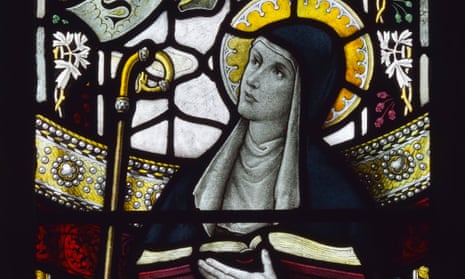There is the eighth-century abbess who wrote the first surviving example of poetry known to have been authored by an Englishwoman. Or her contemporary, a nun who was the first woman to write a full-length prose work in English and hid her name in the text. A new history of women’s writing argues that there was a thriving female literature far earlier than previously believed, and that earlier histories have deliberately excluded or marginalised the contributions of early medieval women.
The first English women’s writing is usually dated to the later middle ages, to the likes of the 12th-century courtly writer Marie de France and 14th-century visionaries Julian of Norwich and Margery Kempe.
Published next month, Diane Watt’s Women, Writing and Religion in England and Beyond, 650–1100 argues that women were at the heart of the emerging English literary tradition much earlier. Watt, a professor at the University of Surrey, lays out in the book how some anonymous texts from the period were probably created by women, and contends that men rewrote works originally produced by women.
“There was a vibrant literary culture that women were involved in, in a whole range of ways, before the Norman conquest. There’s a big Latin tradition preceding that which isn’t considered, partly because it’s in Latin and partly because the picture hasn’t been put together,” said Watt. “People might notice isolated cases of women’s writing, but the evidence hasn’t been put together.”
Her book brings a host of early female writers together, including Leoba, an English missionary and abbess of Tauberbischofsheim in Franconia who died in 782; and Hugeburc, an English nun who joined the Benedictine monastery of Heidenheim. Leoba’s one surviving letter features the earliest example of poetry by an Englishwoman (“Farewell, and may you live long and happily, making intercession for me,” runs Watt’s translation from the Latin), while Hugeburc wrote an account of the lives of the brothers St Willibald and St Winnebald. Hugeburc is seen as the first named English woman writer of a full-length narrative, with her authorship of the text only discovered in the 20th century, when her name was found to be encrypted in the manuscript. Unencrypted, the Latin reads: “Ego una Saxonica nomine Hugeburc ordinando hec scribebam,” or “I, a Saxon nun named Hugeburc, wrote this”.
“There isn’t a modern translation so it’s not something people could go and read, but a text like that is so important,” said Watt. “And for Leoba, who was a close supporter of St Boniface, her very first letter to him includes lines of verse, which she’s composing in order to impress him. It seems to work because he subsequently invites her to travel to Germany to join the mission. She’s using poetry almost [as a] CV. So we know women were writing poetry back then.”
Watt also argues that an anonymous eighth-century Life of Gregory the Great could have been produced by one of the nuns in Whitby’s double monastery, not necessarily by a monk. “The emphasis on women within the text would seem to reflect the interests of women, which would seem to suggest female authorship,” she said.
She also makes the case that monastic writers of the time “overwrote” accounts by women of their own histories. One example, she claims, is Bede, who did not name the authors of the local books he drew upon for his account of the early abbesses of the English church in his Ecclesiastical History of the English People.
“I’m 99.9% sure that these early sources were written by women, the early communities themselves producing their own histories,” said Watt. “Bede came along and took these sources and incorporated them … It’s not a deliberate censorship, but you have a major writer like Bede coming along, and his becomes the definitive text, and the earlier ones become redundant.”
It wasn’t only medieval monks overlooking the work of women. Watt writes that that even recently published studies of literary history continue to give short shrift to women, especially in relation to the pre-modern period.
“I think the field of medieval literature is very slow to change, if I’m honest,” she said. “What I’m trying to do in this book is a lot of the groundwork for the texts available, because the texts are in Latin [and] Old English, so you have to have quite specific scholarly skills to access this material.”
Watt believes that understanding women writers’ contribution is vital to understanding the period itself. “Our understanding of the period as a whole is diminished by not acknowledging their contributions,” she said.
